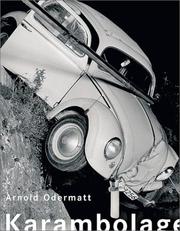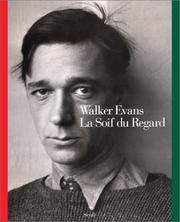| Listing 1 - 10 of 185 | << page >> |
Sort by
|
Book
ISBN: 9782021060003 2021060004 Year: 2012 Publisher: Paris: Seuil,
Abstract | Keywords | Export | Availability | Bookmark
 Loading...
Loading...Choose an application
- Reference Manager
- EndNote
- RefWorks (Direct export to RefWorks)
Les albums de Lartigue constituent la première entreprise autobiographique photographique connue à ce jour, ainsi qu'un témoignage sans précédent sur le siècle passé, autant que sur l'art de ce grand photographe. Adoptant le format "à l'italienne' des albums d'origine, reproduisant toute la subtilité des images et de leur mise en page, cet ouvrage dévoile enfin, de façon exhaustive, ce que chacun attendait de voir dans l'œuvre de Lartigue, son "déroulé' chronologique, qui retrace dans leur véritable contexte de production et de présentation les images de ce photographe amateur génial, reconnu dès 1963 par la critique américaine comme l'un des plus grands photographes de son temps.

ISBN: 3882438665 9783882438666 Year: 2003 Publisher: Göttingen: Steidl,
Abstract | Keywords | Export | Availability | Bookmark
 Loading...
Loading...Choose an application
- Reference Manager
- EndNote
- RefWorks (Direct export to RefWorks)
With thoroughness and a meticulous attention to detail, Arnold Odermatt photographed automobile accidents on the streets of the Swiss canton of Nidwalden between 1939 and 1993. For 40 years, the Swiss police office recorded the wrecked cars left in the wake of excessive speed, drunk driving, right-of-way errors, and plain foolishness, in poignant, sometimes funny, and always strange atmospheric photographs. Though Odermatt was not formally trained as a photographer, he made images that evidence a studied appreciation for romantic landscape scenes and a simultaneous attention to the clinical detail of an accident of police procedure. He created them as a personal corollary to the documentary photographs that typically accompany police and accident reports in his picturesque Alpine country. Art historically, they call to mind such diverse sources as Weegee's scene-of-the-crime pictures from the 1930s and 40s, and Andy Warhol's interest in the banal spectacle of disaster and accident in the 1960s. Wholly original and surprising, beautiful and haunting, Odermatt's pictures were only recently introduced to the art world--when Harald Szeeman exhibited them at the 49th Venice Biennale, they were virtually unknown.
Book
ISBN: 9782020962742 2020962748 Year: 2007 Publisher: Paris Ed. du Seuil
Abstract | Keywords | Export | Availability | Bookmark
 Loading...
Loading...Choose an application
- Reference Manager
- EndNote
- RefWorks (Direct export to RefWorks)
"Après plus de trente-cinq années de pratique photographique, et un certain nombre d'écrits qu'il a consacrés tantôt aux photographies des autres, tantôt à ses propres images, il revenait à Denis Roche de tracer non pas le bilan, mais le parcours, l'itinéraire, de la manière la plus chronologique possible, d'un artiste qui va lier sans cesse, en les approfondissant, l'autobiographie et la réflexion sur l'acte photographique, le hasard de la prise de vue et l'inconscient au travail. Il s'est avéré que la meilleure façon de le faire était de recourir à l'entretien, d'abord parce que les questions de Gilles Mora étaient souvent inattendues et, quelquefois, dérangeantes. Ensuite parce que la parole, ainsi soumise au dialogue, se révèle plus libre et que, dans sa flexibilité, elle permet de faire sauter quelques verrous, sur l'intime, par exemple, et son rapport quasi obsessionnel avec la mort, ou bien encore sur la tentation de ce que Denis Roche lui-même appelle " la dernière photographie ". On y verra aussi percer, çà et là, l'écho - c'est lui qui le dit - d'une autre recherche, d'un autre approfondissement, purement littéraire celui-là, qui serait, lui aussi, interminable.
Book
ISBN: 0954337476 9780954337476 Year: 2006 Publisher: London: The association of photographers,
Abstract | Keywords | Export | Availability | Bookmark
 Loading...
Loading...Choose an application
- Reference Manager
- EndNote
- RefWorks (Direct export to RefWorks)
AOP (Association Of Photographers) réuni des photographes professionels, protège et promeut leurs oeuvres. AOP soutient les photographes et ce qui se fait de mieux en photographie.
Book
ISBN: 9788415715931 8415715935 Year: 2016 Publisher: Madrid: Casimiro,
Abstract | Keywords | Export | Availability | Bookmark
 Loading...
Loading...Choose an application
- Reference Manager
- EndNote
- RefWorks (Direct export to RefWorks)
"En 1864, quand elle eut cinquante ans, son fils lui offrit un appareil photographique. Ce présent lui fournit enfin l'exutoire à l'énergie qu'elle avait consumée en poésie, en romans, à refaire les maisons, à concocter des currys et à divertir ses amis. Elle devint dès lors une photographe. Toute sa sensibilité s'exprimait, et - ce qui était probablement plus important - était jugulée dans cet art naissant." Virginia Woolf.
Book
ISBN: 2867540984 9782867540981 Year: 1995 Publisher: Paris: Centre national de la photographie,
Abstract | Keywords | Export | Availability | Bookmark
 Loading...
Loading...Choose an application
- Reference Manager
- EndNote
- RefWorks (Direct export to RefWorks)
Book
ISBN: 3869307145 9783869307145 Year: 2014 Publisher: Göttingen, Niedersachs: Steidl,
Abstract | Keywords | Export | Availability | Bookmark
 Loading...
Loading...Choose an application
- Reference Manager
- EndNote
- RefWorks (Direct export to RefWorks)
Between 1999 and 2011, David Goldblatt did work that he had not previously attempted: personal photography in color. While he had used color extensively in professional work since 1964, he had done almost no personal photography in this medium. But with the new political dispensation as well as technical advances through digital reproduction from film he felt the time was right for him to photograph in color. At first, Goldblatt photographed in his immediate area, Johannesburg. He then decided to look at South Africa by taking photographs within no more than a radius of 500 meters of each of the 122 points of intersection of a whole degree of latitude and a whole degree of longitude within its borders. However, after going to a number of intersections where there was nothing at all that stirred him to photograph, he realized that he was in danger of becoming slave to a formula. After abandoning the initial project he retained the idea of intersections. From time to time, over a period of nine years, he travelled the country in search of intersections-intersections of ideas, values, histories, conflicts, congruencies, fears, joys and aspirations-and the land in which and often because of which these happened.This book brings together a selection of Goldblatt's color photography in South Africa from 2002 to 2011. An earlier version, Intersections, was published by Prestel in 2005, and the catalogue Intersections Intersected, consisting of paired black-and-white and color photographs, was published by Serralves Museum, Porto, in 2008.
Book
ISBN: 8890841877 9788890841873 Year: 2015 Publisher: Milano: Humboldt,
Abstract | Keywords | Export | Availability | Bookmark
 Loading...
Loading...Choose an application
- Reference Manager
- EndNote
- RefWorks (Direct export to RefWorks)
In the summer of 1970, Gabriele Basilico set off from Milan in a Fiat 124, nominally heading for Kabul. The journey towards India was a rite of passage for the flower children generation, and Basilico had plans to take a series of photos to then sell on to some magazine. The journey didn't quite turn out as planned, but in his personal archive, those shots were carefully stored away, and on more than one occasion, the Milanese photographer thought about turning them into a book.
Photographe --- Basilico, Gabriele --- Iran
Book
Abstract | Keywords | Export | Availability | Bookmark
 Loading...
Loading...Choose an application
- Reference Manager
- EndNote
- RefWorks (Direct export to RefWorks)
Photographe --- Cinéma --- Japon

ISBN: 9782020164504 2020164507 Year: 1993 Publisher: Paris: Seuil,
Abstract | Keywords | Export | Availability | Bookmark
 Loading...
Loading...Choose an application
- Reference Manager
- EndNote
- RefWorks (Direct export to RefWorks)
Monographie de Walker Evans dans laquelle l'auteur a retenu des séquences, toutes ont une valeur exemplaire pour montrer l'évolution des thèmes et des idées ayant constamment hanté son travail
| Listing 1 - 10 of 185 | << page >> |
Sort by
|

 Search
Search Feedback
Feedback About UniCat
About UniCat  Help
Help News
News